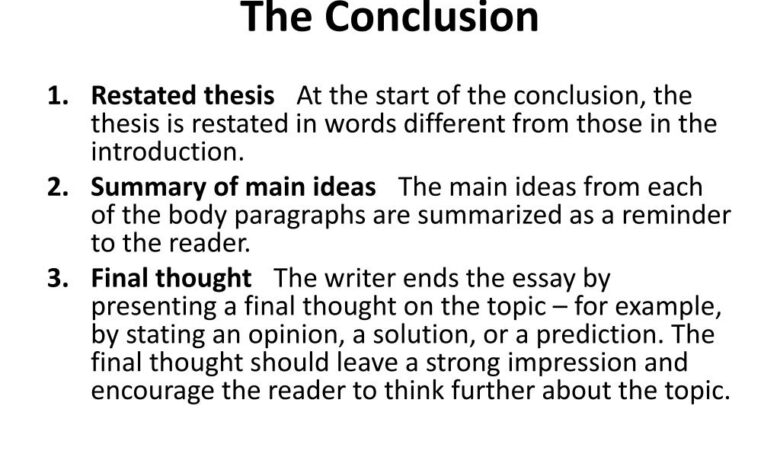How to Start a Conclusion?

It is always a difficult task to write a conclusion. To write a convincing conclusion, not everybody is very sure how to start an essay. However, if you can follow a few guidelines below, you will produce a fantastic conclusion that people will always remember. In any writing that you do for school, work, or personal reasons, you must understand how to end the piece properly. In this article, you will be introduced to how a conclusion can be written and the tips which will be useful. And if you need any kind of support then the Essay writers in the UK is there to support you.
Restate the Main Idea
In general, it is always useful in coming up with a conclusion to bear in mind, the purpose of the writing. There’s no way you are going to say the same thing all over again in the body section as you stated in the introduction section. In this case, it is better to attempt, to paraphrase the main idea in a new fashion. People need to be reminded of what it was that you were writing about in your essay and this is where repeating an idea comes in handy. It also shows that you are in the process of concluding and that you are summarizing all the aspects of your argument.
Summarize the Key Points
After restating the thesis, you can look at the points you discussed in the essay in a nutshell. Never should there be new ideas as you draw your conclusion in a good conclusion. It does not bring out new issues, but it rather rehashes all the issues that have been raised. This summary therefore aids in sustaining your thesis statement and creates the impression of an essay being fully polished.
For instance, if you were writing a topic about healthy eating, you could conclude it like this; “Thus, the consumption of healthy foods can work wonders to both our health and well being as well as increase our energy level.” This tells the reader what you have been writing about without reading the entire passage again.
Use Transition Words
Some words enable a writer to join your conclusion to the rest of the text, without creating any jerks. Pre-signal words include words such as ‘in conclusion,’ ‘to sum up’ or ‘in summary’ which indicate that you are about to conclude. These words leave a clear indication that the reader has gone through the last section of your essay. It provides a transition from one phrase or sentential element to the other and makes the flow of your writing smooth thus making your work easier. For example, rather than pointing off a new idea in your conclusion you might write, “In conclusion, a healthy diet is important for a happy, long life.
Avoid New Information
Perhaps the most common absurdity that people commit and then build into their conclusions is new positives. The conclusion should be based on what has already been stated and not new points to be made. In particular, if you provide new information at the end, it will only bewilder your readers. It may also make you feel that your essay should continue.
To this, avoid giving conclusions but only summarize your body and re-state your purpose of writing. It is at this point that the reader should not be left with more questions than answers to the laid down arguments.
Make It Impactful
Your conclusion is the final section of the essay and therefore it should leave an excellent impression. It’s good to try and close with a strong statement that will leave the reader to ponder. This can be done by adding an endnote or an appeal for action in the conclusion. Students often use Best Essay Writing Service in UK for making their conclusions and assignments impactful.
For instance, if your essay was about healthy eating, then you could write, “Now is the time to make better decisions and give our health a future.” This call to action makes the reader think deeper than what he/she has read.
Keep It Short and Simple
The conclusion doesn’t have to be a considerable amount of words at all. However, it is often the case that an abrupt and concise conclusion contributes to being more impactful than a lengthy conclusion. It should be between 5-7 sentences which should recapture the theme or main thought, and major points, and create a benevolent impression. To that effect, keeping the conclusion short will guarantee that you do not complicate it in any way.
Relation to the Introduction This chapter brings excursions and tourism into focus and raises the question of whether it is possible to have German excursions without tourists. It looks into how German excursions have been imagined and turned into an object of public curiosity and fascination.
Another outstanding suggestion is to relate your conclusion to the introduction part since it will help to create a circle. This has resulted in shaping a logical conclusion and rhythm that prevails in the presentation. One of the ways how this can be done is by going back to a concept, quotation, or question made at the start of the given article. For instance, if your introduction posed a question, as in the case of the instance: “Why healthy eating?” then the conclusion can state, “It is because healthy eating makes man live longer and healthier.” This way the circle of ideas is complete.
Edit and Revise
As with every type of academic writing, I had to read through the conclusion at least once. Ensure that it gives a brief conclusion without adding new content to your essay. However, make sure there is no mistake and it fits well when connected to the rest of your written text. If it is too vague, or even if it is just overly complicated, it means that one needs to edit the text.





